p.349
p.355
p.360
p.364
p.368
p.373
p.379
p.383
p.387
Preparation of ZnO/PANI Nanocomposite and Study on its Photocatalytic Properties
Abstract:
Polyaniline (PANI)/zinc oxide (ZnO) nanocomposites have been synthesized by in-situ polymerization of aniline monomer with ZnO nanomaterials. The PANI/ZnO nanocomposites were used as photocatalyst in the photodegradation of methylene blue dye (MB) molecules in aqueous solution. The results showed that PANI/ZnO nanocomposite greatly enhanced photocatalytic activities compared with pristine polyaniline might due to high photoexcited electronhole pairs charge separation. The photocatalytic activities of PANI/ZnO nanocomposites increased with increasing ZnO content, however, further increasing ZnO content over 50% induced the formation of more agglomerates, which could act as recombination centers of photoexcited electronhole pairs, leading to decreased photocatalytic activity. The kinetics of photodegradation of MB dye using PANI/ZnO(ZnO content 50 % ) nanocomposites photocatalyst was found to be of the first order.
Info:
Periodical:
Pages:
368-372
Citation:
Online since:
July 2013
Authors:
Keywords:
Price:
Сopyright:
© 2013 Trans Tech Publications Ltd. All Rights Reserved
Share:
Citation:


